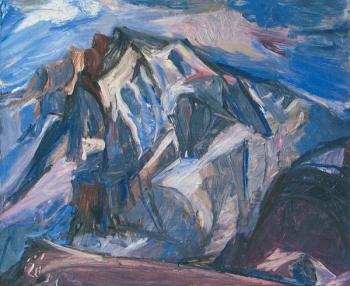JANE CULP IS THE WIDOW of painter Louis Finkelstein (d. 2000). He was a widower himself when they married. His first wife, painter Gretna Campbell died in 1987. Culp’s own painting carries echoes of both her husband and her predecessor. Louis’ fracturing of form and well-known admiration for Cezanne is visible in her landscapes and charcoal drawings. Gretna Campbell’s interest in wild locale, Maine’s Cranberry Isles, finds its correspondent in Culp’s chosen terrain: the California deserts.

I like Culp’s painting. No argument there. While I prefer the greater discipline of Campbell’s approach to her motifs over Culp’s looser expressionism, that is simply a matter of taste. Culp is an accomplished paint-handler and a lively, satisfying colorist. Looking at her current exhibition in Bowery Gallery, a Chelsea coop, I had two reactions. First, the influence of Cezanne remains wonderfully fruitful. If the whole of modern painting after him were declared inadmissible, talented painters would continue to enliven depiction on the basis of his example alone. Secondly, it is hard to make sense of why some artists remain in co-ops while others, often less good, appear in more prestigious galleries. With the exception of two watery ink washes of a raven, everything on show holds its own. There is no visible rhyme or reason for it not hanging in any number of galleries on the block.
In the end, though, what really interests me here—more than the painting—is the crafted self-image that Culp uses to promote the work. From the spectrum of possibilities every life offers for self-definition, Culp chooses a variant of back-to-the-land romanticism. Her constructed self is a tad too precious, too smug in its assumption of her own uniqueness. Her catalogue came accompanied by a cover letter that does not hesitate to tell me how to think about her art and her own uncommon, sustainable self.
In referring to herself, she will not use the upper case “I”. Only the lower case—a clear signal of narcissistic play-acting. Setting oneself above customary usage is a contrived attempt at humility that indicates the very opposite of what is intended. Herewith, a portion of her broadcast letter:
My work has never looked so good, its [sic] taken 45 years to make what i think are dynamite paintings. . . . Artists like me give the city diversity. You probably remember my late husband Louis Finkelstein.
Out west i live in a straw bale cabin that is totally off grid; it keeps me a part of my paintings. The raven, Kaw, in two of the drawings . . . died last summer at 25 years old. i feel priviledged [sic] to have known him for 10 of those years. He would come down from the sky when I called him . . . and stomp on the roof of my cabin loudly when he wanted some hamburger or scrambled eggs.
Then the letter goes on to include compliments from a “long time human friend.” The artist wants us to know she is in communion with nature, not superior to it like the rest of us who refer to ourselves in the upper case. Kevin Costner might warm to this sort of thing but I do not. That bird had the good sense to keep tabs on a meal ticket when he saw one. The artist, in her pompous humility, feels “priviledged” to have been one. At least she is not a vegetarian. Neither are ravens.
Perhaps the saddest part of this is her confidence that living in a straw shack, with no electricity, makes her part of her paintings. She and them—mere molecules of stuff poised for dispersion. Why keep the lights on for that?
This is where the ideology of art takes us. Each to her own pipe dream. It is a route to the Third World.
© 2010 Maureen Mullarkey
Note: Presumably, Culp is on the grid part of the year. The catalogue was mailed from an address in upstate New York.
Also, one reader emails to say that the life span of a raven in the wild is 10-12 years. No wonder Kaw followed Culp around. Friendship had nothing to do with it. Another asks if the bird carried papers. How else could anyone know it was 25 years old?


